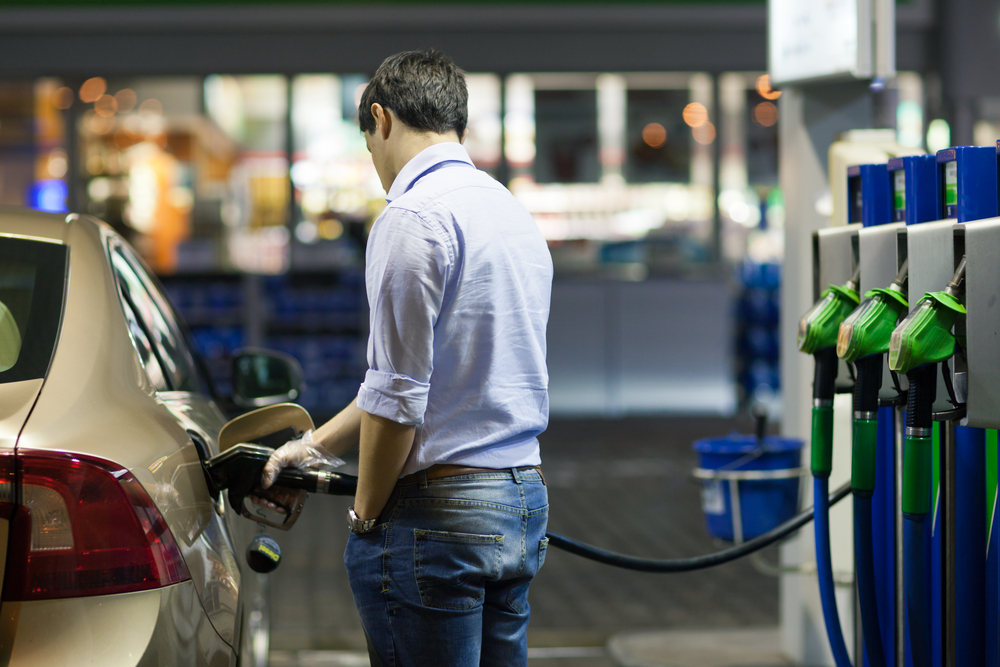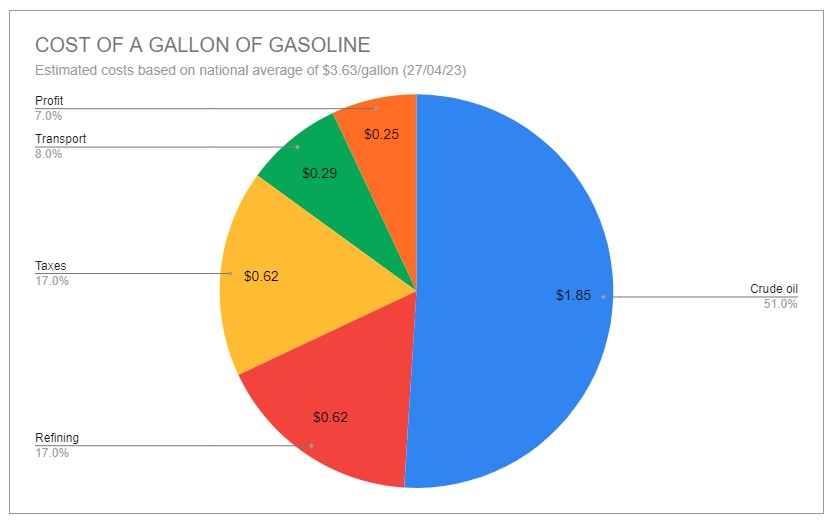Gas stations have been a crucial part of the transportation infrastructure for over a century. As car ownership grew, gas stations and convenience stores became familiar and abundant across the U.S., creating a highly lucrative and competitive industry.
Changing consumer needs transformed gas stations from simple fuel pumps to shopping, eating, and resting destinations – but with the advent of electric vehicles, what does the future hold for them?
In this report, we review the latest data on the industry, including ownership, profitability, consumer behavior, crime, and future projections.

GENERAL GAS STATION STATISTICS
- There are approximately 147,000 gas stations in total across the U.S.
- As of April 2023, there are 150,174 convenience stores, of which 118,678 stores (79%) sell fuel.
- Other locations that sell gasoline are fuel-only kiosks (13,346 outlets), hypermarkets such as Costco and Walmart (6,648 outlets), and small-volume locations such as service stations and marinas (approximately 8,000 outlets).
- 80% of gasoline purchased in the U.S. is sold in convenience stores.
- 93% of Americans live within 10 minutes of a gas station.
- 15% of the fuel retailing market is controlled by larger chains of 500+ stores such as Wawa, 7-Eleven, and Sheetz.
- 62.1% of the fuel retailing market is comprised of single-store owners, in other words, individuals who independently own and operate one store.
- There are more than 100,000 companies in the convenience and fuel retailing industry in the U.S.
- The first commercial fuel pump in the U.S. was sold to a grocery store in Fort Wayne, Indiana, in 1885.
- The first drive-in service station opened in 1913 in Pittsburgh, Pennsylvania.
- While most gas stations operate a self-serve model, two states, Oregon and New Jersey, prohibit customers from filling their cars with gasoline. Instead, a gas station attendant pumps fuel into a customer’s vehicle.
- There are 144,603 alternative fuel stations, the majority of which are electric vehicle supply equipment (EVSE) ports:
Fuel Type | Number of Stations |
Biodiesel | 823 |
Compressed Natural Gas | 776 |
E85 – Ethanol Flex Fuel | 4,246 |
Electric¹ | 135,534 |
61 | |
Liquefied Natural Gas | 51 |
Propane | 2,537 |
Renewable Diesel | 575 |
Total | 144,603 |
*1,52,463 electric stations provide 135,534 individual EVSE ports
GAS STATION COMMERCIAL INSIGHTS
- The profit margin on fuel is low – the below chart shows the gross profit per gallon of gasoline:

- When factoring in the costs of labor, utilities, insurance, and credit card transaction fees, the net profit per gallon is around $0.03-$0.07.
- 44% of gas station customers go inside the attached convenience store.
- Over ⅓ of gas station customers make a non-fuel purchase at the convenience store, which has far healthier profit margins of up to around 55%.
- Non-fuel items (food, beverages, cigarettes, etc.) comprise around 30% of gas station revenue but account for 70% of the profit.
- The average fueling location sells about 3,000 gallons of gas per day, equivalent to 1,095,000 gallons per year. Hypermarkets can sell up to five times this amount.
GAS STATION CONSUMER BEHAVIOUR AND CONSUMPTION
- Nearly 40 million Americans fill up their vehicles with gasoline every day.
- 59% of drivers decide where to buy fuel based on the price.
- Consumers are more likely to buy gas during the evening rush hour than in the morning (33% vs. 22%) because of morning time pressures.
- The average time to fill up a vehicle is two minutes.
- The average person in the U.S. fills their car with gas roughly every week to 10 days. The frequency depends on the gas tank size, how far and frequently they drive, and the vehicle’s fuel efficiency.
- A smaller car with a tank that holds 12 gallons costs $43.56 to fill (using the current average cost of $3.63/gallon). Assuming the car is filled every week, the annual cost of gasoline is $2,265.
- Americans traveled an estimated 9.117 billion miles per day in 2022. With 275.9 million registered vehicles in the U.S., the average vehicle traveled approximately 33 miles per day.
- In 2022, approximately 134.55 billion gallons (or about 3.20 billion barrels) of gasoline were consumed in the U.S., an average of around 369 million gallons per day (or about 8.78 million barrels per day).
- The average gasoline consumption per registered vehicle is 488 gallons/year.
GAS STATION CRIME AND ACCIDENT STATISTICS
- In 2021, convenience stores accounted for 3% of violent crimes, and gas stations accounted for about 2%.
- Convenience stores and gas stations are the fifth and seventh most common locations for violent crime, respectively.
- 221 or 1% of the 22,788 total crimes at convenience stores were homicides; 176 or 1% of the 14,649 total crimes at gas stations were homicides.
- The FBI reported 160,101 total robberies in 2021: 14,531, or 9%, were at convenience stores, while 7,941, or 5%, were at gas stations.
- Between 2014 and 2018, there were 4,150 fires on average at service or gas stations annually.
- Fires caused an average of three civilian deaths, 43 civilian fire injuries, and $30 million in direct property damage annually.
- More than half of the fires (56%) at gas stations were vehicle fires, caused by mechanical and electrical failures or malfunctions.
GAS STATION TRENDS AND PROJECTIONS
- The business model of “cokes, smokes, and gasoline” is being replaced with innovative store formats and diversified product ranges, for example, locally sourced organic produce, juice bars, car washes, eat-in restaurants, and diners.
- Some individual owners and smaller independent chains struggle to adapt to this new landscape. There were 569 store closures in 2019 versus 2018 among operators with ten stores or fewer. Conversely, chains of 500+ stores grew during this time, with 312 additional new stores in 2019 versus 2018.
- The cultural shift to working from home and the adoption of electric vehicles (EVs) puts the future of gas stations in jeopardy. EVs will replace gasoline-fueled vehicles by as early as 2035 in some states. Consequently, up to 80% of stations are forecast to be unprofitable by that time.
- EVs take approximately 20 minutes to charge, so the existing design and layout of gas stations (which facilitate a quick turnaround of cars) cannot be easily adapted to accommodate EVs.
- Gas stations that provide service and repairs will also decline because EVs are more reliable, do not require oil changes, and have fewer moving parts.
- It is predicted that most gas stations, particularly in urban areas, will be sold off and redeveloped into residential and commercial buildings. Gas station sites are desirable because they are usually in central, high-traffic locations with no preservation orders.
Conclusion
Gas stations continue to play a vital role in transportation infrastructure, but the industry has an unstable future. While business owners have pivoted their strategy over the years to accommodate shifting consumer demands, the transition to electric vehicles may prove too big a change for many of them. Installing electric charging points requires significant investment and site redesign, which small business owners cannot afford to do.
With ever-increasing competition and the adoption of EVs, the only way gas stations can survive is to differentiate themselves by offering additional services and experiences, diversifying their product ranges, and investing in electric charging ports. Inevitably, a trip to a convenience store or gas station will become a much rarer activity in the not-too-distant future.
Sources:
- https://www.youtube.com/watch?v=z7aDDETvh1M
- https://www.convenience.org/Research/Convenience-Store-Fast-Facts-and-Stats/FactSheets/IndustryStoreCount
- https://www.youtube.com/watch?v=Lb7TMaip21E
- https://afdc.energy.gov/stations/states
- https://thehustle.co/why-most-gas-stations-dont-make-money-from-selling-gas/
- https://www.convenience.org/Topics/Fuels/Who-Sells-Americas-Fuel#.WsKUICMrIy4
- https://www.finder.com/gas-prices#source
- https://www.api.org/oil-and-natural-gas/consumer-information/consumer-resources/staying-safe-pump
- https://www.convenience.org/topics/fuels/documents/how-consumers-react-to-gas-prices.pdf
- https://drivinvibin.com/2022/07/13/gas-rule/
- https://www.eia.gov/tools/faqs/faq.php
- https://www.api.org/news-policy-and-issues/blog/2022/05/26/top-numbers-driving-americas-gasoline-demand
- https://cde.ucr.cjis.gov/LATEST/webapp/#/pages/explorer/crime/crime-trend
- https://www.nfpa.org//-/media/Files/News-and-Research/Fire-statistics-and-reports/Building-and-life-safety/osservicestations.pdf
- https://www.api.org/oil-and-natural-gas/consumer-information/consumer-resources/service-station-faqs
- https://www.governing.com/next/as-evs-gain-popularity-what-will-happen-to-gas-stations
